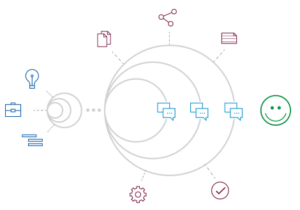In the current era of technology, a new way of creating software has taken the software development and testing world by storm: Agile.
Note: I work at Ontoborn.com. We are experts in agile software development. Pretty much all of our development work is in agile. Feel free to talk to us if you’d like us to help you with your agile project.
Tip: Developers, Team Leaders, Project Managers, Product Managers, Development Managers, Testers, QA Managers, QA Engineers, Technical Writers, UX Designers, anyone involved in the delivering software can read this article.
source: Versionone.com
What is Agile?
Agile software development describes an approach to software development under which requirements and solutions evolve through the collaborative effort of self-organizing and cross-functional teams and their customers.
The most popular agile methodologies include Extreme Programming (XP), Scrum, Crystal, Dynamic Systems Development Method (DSDM), Lean Development, and Feature-Driven Development (FDD).
It advocates adaptive planning, evolutionary development, early delivery, and continual improvement, and it encourages rapid and flexible response to change.
Agile Manifesto:
There are four rules
- Individuals and Interactions over processes and tools
- Working Software over comprehensive documentation
- Customer Collaboration over contract negotiation
- Responding to Change over following a plan

source: QuickScrum
Manifesto of Agile Software Development principles:
1. Customer satisfaction and valuable software
The highest priority is to satisfy the customer through the early and continuous delivery of valuable software.
2. Dynamic in development
Welcome changing requirements, even late in development. Agile processes harness change for the customer’s competitive advantage.
3. Working software is delivered frequently
Deliver working software frequently, from a couple of weeks to a couple of months, with a preference to the shorter timescale.
4. Cooperation between business people and developers
Business people and developers must work together daily throughout the project.
5. Motivate the project developers
Build projects around motivated individuals. Give them the environment and support they need, and trust them to get the job done.
6. F2F Communication
The most efficient and effective method of conveying information to and within a development team is the face-to-face conversation.
7. Progressive measure
Working software is the primary measure of progress.
8. Sustainable development
Agile processes promote sustainable development. The sponsors, developers, and users should be able to maintain a constant pace indefinitely.
9. Attention to technical design
Continuous attention to technical excellence and good design enhances agility.
10. Simplicity
Simplicity the art of maximizing the amount of work not done[is essential].
11. Need of Self-organizing
The best architectures, requirements, and designs emerge from self-organizing teams.
12. Being effective
At regular intervals, the team reflects on how to become more effective, then tunes and adjusts its behaviour accordingly.
Advantages:
- Much has been compared over the years with Agile versus Waterfall approaches.
- In the Waterfall era of software development, coders worked alone, with little to no input before handing the software to testers and then on to production.
- Bugs, complications and feature changes either weren’t handled well or were dealing with so late in the process that projects were seriously delayed or even scrapped.
- The idea the behind the Agile model, in which everyone including the business side stayed involved and informed in the development process, represented a profound change in both the culture and a company’s ability to get better software to market more quickly
- Collaboration and communication became as important as technology, and because the Agile Manifesto is open to interpretation, it has been adapted and modified to fit organizations of all sizes and types.
- The Agile cultural shift also paved the way for the latest software development evolution, DevOps.
Disadvantages:
The biggest disadvantage of this software is the fact it has been modified. Some would say diluted by many organizations. This phenomenon is so widespread that the “Agile my way” practitioners are known as “Scrum buts”.
GO for it: entrepreneurs always seek new ways to do things in an inexpensive, innovative, faster and more productive manner. These days new technologies have developed significantly allowing professionals to do their job online everywhere and at any time.
Get in touch. We’ll be happy to serve you.
[ninja_form id=1]

